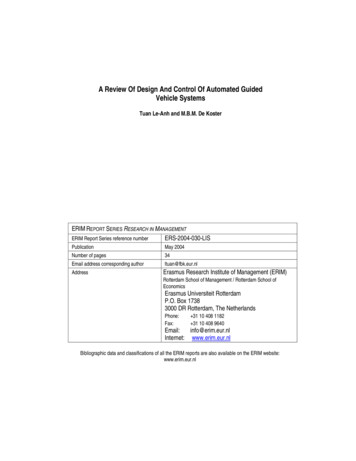
Transcription
A Review Of Design And Control Of Automated GuidedVehicle SystemsTuan Le-Anh and M.B.M. De KosterERIM REPORT SERIES RESEARCH IN MANAGEMENTERIM Report Series reference numberERS-2004-030-LISPublicationMay 2004Number of pages34Email address corresponding authorltuan@fbk.eur.nlAddressErasmus Research Institute of Management (ERIM)Rotterdam School of Management / Rotterdam School ofEconomicsErasmus Universiteit RotterdamP.O. Box 17383000 DR Rotterdam, The NetherlandsPhone:Fax: 31 10 408 1182 31 10 408 9640Email:info@erim.eur.nlInternet: www.erim.eur.nlBibliographic data and classifications of all the ERIM reports are also available on the ERIM website:www.erim.eur.nl
ERASMUS RESEARCH INSTITUTE OF MANAGEMENTREPORT SERIESRESEARCH IN MANAGEMENTBIBLIOGRAPHIC DATA AND CLASSIFICATIONSAbstractLibrary of CongressClassification(LCC)Journal of EconomicLiterature(JEL)This paper presents a review on design and control of automated guided vehicle systems. Weaddress most key related issues including guide-path design, estimating the number ofvehicles, vehicle scheduling, idle-vehicle positioning, battery management, vehicle routing, andconflict resolution. We discuss and classify important models and results from key publications inliterature on automated guided vehicle systems, including often-neglected areas, such as idlevehicle positioning and battery management. In addition, we propose a decision framework fordesign and implementation of automated guided vehicle systems, and suggest some fruitfulresearch directions.5001-6182Business5201-5982Business ScienceHE 383Transportation – waterways in relation to other forms oftransportationMBusiness Administration and Business EconomicsM 11Production ManagementR4Transportation SystemsR4Transportation SystemsEuropean Business SchoolsLibrary Group85 ABusiness General(EBSLG)260 KLogistics240 BInformation Systems Management260 KLogisticsGemeenschappelijke Onderwerpsontsluiting (GOO)Classification GOOKeywords GOO85.00Bedrijfskunde, Organisatiekunde: algemeen85.3485.20Logistiek managementBestuurlijke informatie, informatieverzorging85.34Logistiek managementBedrijfskunde / BedrijfseconomieBedrijfsprocessen, logistiek, management informatiesystemenFree keywordsGoederenoverslag; Automated guided vehicles, literatuuroverzichtenMaterial handling system; Automated guided vehicle; Literature overview
A REVIEW OF DESIGN AND CONTROL OFAUTOMATED GUIDED VEHICLE SYSTEMSTuan Le-Anh*, MBM De KosterRotterdam School of Management, Erasmus University Rotterdam, P.O. Box 1738, 3000 DR Rotterdam, The Netherlands*Corresponding author. Tel.: 31 10 4082027; fax: 31 10 408 9014; e-mail LTuan@fbk.eur.nlAbstractThis paper presents a review on design and control of automated guided vehicle systems. Weaddress most key related issues including guide-path design, estimating the number ofvehicles, vehicle scheduling, idle-vehicle positioning, battery management, vehicle routing,and conflict resolution. We discuss and classify important models and results from keypublications in literature on automated guided vehicle systems, including often-neglectedareas, such as idle-vehicle positioning and battery management. In addition, we propose adecision framework for design and implementation of automated guided vehicle systems, andsuggest some fruitful research directions.Keywords: Material handling system; Automated guided vehicle; Literature overview1IntroductionMaterial handling systems using automated guided vehicles (AGVs) are commonly used infacilities such as manufacturing plants, warehouses, distribution centers and terminals. Figure1 gives an example of such a material handling system in a distribution center of computerhard and software (De Koster et al., 2004), in which guided vehicles transport pallets (loads)between locations, e.g. from receiving lanes to storage areas, and from storage areas toshipping lanes.1
(18)P & D Storage Module 1Overflow Storage(10)AreaVehicle tracksOdd-Size Area(8)AreasMain flowsRPACRAParkingAreaSRA LabelingAreaCheck - In Area(12)Return Stations(5)Shipping Lanes(6)Receiving Lanes(5)Figure 1 The guided-vehicle system of a distribution centerThe performance of the material handling system directly affects the performance of thewhole facility. Basically, the relevant issues at facilities using automated guided vehicles canbe divided into the following main categories: guide-path design, estimating the requirednumber of vehicles, vehicle scheduling, idle-vehicle positioning, battery management,vehicle routing and conflict resolution. These issues relate to different levels of the decisionmaking process. The guide-path design problem can be seen as a problem at strategic level.The decision at this stage has a strong effect on decisions at other levels. Issues at tacticallevel include estimating the number of vehicles, scheduling vehicle, positioning idle vehiclesand, managing battery-charging scheme. Finally, the vehicle routing and conflict resolutionproblems are addressed at the operational level. During the design and implementationprocess, some interactions and iterations can be seen between steps. The type of the guidepath system directly influences the number of vehicles required and the complexity of thevehicle scheduling system. The scheduling system also affects the number of vehiclesrequired.Modern AGV systems differ from the classic ones as described for instance in the books ofJünemann and Schmidt (2000) and Tompkins et al. (2003) in several respects. Rather thanusing fixed paths, many modern AGVs are free-ranging, which means their preferred tracksare software programmed, and can be changed relatively easy when new stations or flows areadded. A second difference is in the way they can be controlled. Agent technology allowsdecisions to be taken by these smart vehicles that in the past were taken by centralcontrollers. This leads to adaptive, self-learning systems and is particularly appropriate forlarge, complex systems with many vehicles and much potential vehicle interference. Thesedevelopments do not imply that the traditional decision-making problems become obsolete.2
Rather, they lead to new challenges for research. We both discuss the traditional AGV systemdecision-making problems and the impact of these developments on decision-making.There are few review papers on AGV systems. However, they concentrate on only limitedparts of the problem (Qiu et al. (2002) focus on scheduling and routing problems) or are notup to date (Sinriech, 1995; Co and Tanchoco, 1991; King and Wilson, 1991). Moreover, theyignore some areas such as idle-vehicle positioning and battery management. This paperattempts to fill this gap, by giving an extended overview of existing literature, including themost recent contributions, and also structures the design and implementation decision processfor AGV systems. For each area, we review and classify key decision models. In addition, anew classification for dispatching rules, a guideline for selecting a suitable scheduling systemand a decision framework for design and implementation of AGV systems are proposed. Wealso consider idle-vehicle positioning and battery management problem, which many reviewpapers neglect. Finally, we make suggestions for some fruitful future research directions.We start with an introduction to AGV systems followed by a discussion of guide-path designin section 2. Section 3 investigates the problem of determining the required number of singleor multi-load vehicles. Section 4 reviews the problem of managing an AGV system includingonline and offline scheduling, vehicle dispatching, idle-vehicle positioning, batterymanagement, vehicle routing and conflict resolution. In section 5, we illustrate the design andimplementation decision process of an AGV system by a decision framework. Finally, insection 6 we draw conclusions and identify subjects for further research.2Guide-path designGuide-path design is an important problem in AGV system design and is one of the very firstproblems to be considered. The guide-path depends greatly on the allocation of shop-floorspace, layout of storage zones and the arrangement of handling stations. In most cases, theshop-floor space is fixed and it imposes constraints on the guide-path design problem. Thevehicle guide-path is usually represented such that aisle intersections, pick-up and delivery(P/D) locations can be considered as nodes on a graph connected by a set of arcs. The arcsdescribe the paths that vehicles can follow when moving from node to node. Directed arcsbetween two nodes indicate the direction of the vehicle flow. Cost can be assigned to each arcrepresenting the distance between the two end points of a segment or the time required by a3
vehicle to travel along the arc. This representation can be seen as a network-based system thatis useful for formulating the guide-path design problem. The guide-path system can beclassified by the characteristics indicated in Table 1 and will be explained further in the nextsection.Table 1 Characteristics of guide-path systemsFlow topologyNumber of parallel lanesFlow directionConventionalSingle laneUnidirectional flowSingle-loopMultiple lanesBidirectional flowTandemThe first strategically important issue here is selecting the performance criteria for designinga guide-path system.2.1Performance criteriaAn important question is which performance criteria are most important for the guide-pathdesign problem. Beamon (1998) describes several important performance criteria forautomated guided vehicle systems such as vehicle travel time, vehicle utilization, queuelength, and material handling cost. The most common performance criterion in guide-pathdesign is minimizing the total vehicle travel distance corresponding to a given layout andflows (Gaskins and Tanchoco, 1987; Kaspi and Tanchoco, 1990). Kaspi et al. (2002) includeboth the vehicle loaded and empty travel time in the objective function. Lim et al. (2002) usethe total vehicle travel time (including the loaded and empty vehicle travel and waiting timecaused by congestion or vehicle interferences) as the objective function. Several authors usemultiple objectives. Kim and Tanchoco (1993) consider the travel cost and the cost of eachpath segment. Chen et al. (1999) use the total vehicle travel time and the trip failure rate asperformance measures for their model. Talbot (2003) uses the required number of vehiclesand the guide-path length to measure the system performance. Generally, multi-criteriaobjective functions lead to a better solution quality.The next three sections review the design problem for the three most important guide-pathsystems in literature. The literature does not clearly indicate when and where a specific typeshould be selected, but based on the system requirements, characteristics of facilities and ofeach guide-path system, decision makers can select one of them for their system.4
2.2Conventional guide-path systemA conventional guide-path system is a network of guide-paths connecting all workstations ina system that have transportation requirements. This network may contain junctions,intersections, and shortcuts. The conventional guide-path can be unidirectional orbidirectional. In the unidirectional guide-path system vehicles travel in only one direction ofthe guide-path. In the bidirectional system, both travel directions are possible. Unidirectional guide-path systemThe unidirectional conventional guide-path system is very popular in practice, particularly inwarehouses or distribution centers (Figure 1). Several authors (Gaskins and Tanchoco, 1987;Gaskins et al., 1989; Goetz and Egbelu, 1990; Kaspi and Tanchoco, 1990; Sinriech andTanchoco, 1991; Kim and Tanchoco, 1993) formulate the guide-path design problem as a 0-1integer-programming (IP) model. These models decide the guide-path sections and theirdirections that minimize the total loaded vehicle travel distance. The size of the guide-pathdesogn IP model can be huge for practical problems. To speed up the solution procedure,Goetz and Egbelu (1990) focus on only the major flows between departments and Sinriechand Tanchoco (1991) consider only intersection nodes in their branch-and-bound algorithm.Ignoring the empty vehicle travel time is the main drawback of above models. Kaspi et al.(2002) propose an improved formulation of the model in Kaspi and Tanchoco (1990) byincorporating the empty vehicle travel in the objective function and reducing the number ofbinary variables. Their formulation is illustrated below:min Lijlm dij Eijlm dijijlmijlmLijlm MZij i, j and l , m (1)(2) Z(3) 1 jjk 1 j i, j L f lm l , mk Lijlm(4)kZij {0,1} l , m(5)iEijlm MZ ij i, j and l , m (8) E f lm m(9) E f lm l(10) E E jkml l , m j (11)mjmlkmlmi Z f lmlklmkZij Z ji 1 i, jij L(6) L jklm l , m j (7)kjlilmlimijmlilmk(12)where N- number of entries in the from-to chart; flm- flow intensity from pick-up node l to delivery node m;dij- length of arc i-j (the distance from node i to an adjacent node j); Ylm- path length from node l to node m;Wml- flow intensity of empty vehicles from delivery station m to pick-up station l; Lijlm- loaded vehicle trafficintensity of l-m delivery path along arc i-j; Eijlm- empty vehicle traffic intensity of m-l delivery path along arci-j; Zij 1 if arc i-j is directed from node i to node j, 0 otherwise; M- a large number.5
The objective function is to minimize both the loaded and empty vehicle travel distance. Theconstraint set (1-4) ensures the connectivity of the network-flow. The constraint sets (5-7)and (8-11) ensures the flow feasibility of the network-flow. This is a mixed-integer (0-1)programming model, which is difficult to solve.They solve this model using a branch-and-bound depth-first search algorithm. The emptyvehicle flow (Wml) is computed during the execution of the search algorithm by solving atransportation problem to distribute empty vehicles from the group of delivery stations to thegroup of pick-up stations to minimize the total distribution flow.Besides empty vehicle travel time, time lost caused by vehicle interference also impacts thequality of solutions. Lim et al. (2002) consider total vehicle travel, including the empty andloaded vehicle travel time and time lost caused by congestion and vehicle interference in thedesign model. They estimate the total vehicle travel time using the Q-learning technique (aprocess of learning how to match states with actions in order to maximize a numericalreward). They show that their results are superior to those of Kim and Tanchoco (1993).Obviously, the quality of their solution depends heavily on the accuracy of the travel timecomputed by the Q-learning process.A more complicated problem is tackled by Johnson and Brandeau (1993, 1994); Al-Sultanand Bozer (1998). Their models select path configuration and the P/D stations at a same time.Al-Sultan and Bozer (1998) use a simulated annealing heuristic to solve the guide-pathdesign problem. In their paper, they also note that the model of Gaskins and Tanchoco (1987)may generate infeasible or non-optimal solutions. Johnson and Brandeau (1993, 1994) use thebenefit of AGV systems and fixed cost of setting a pick-up/delivery (P/D) station as theobjective function instead of total vehicle travel distances. Johnson and Brandeau (1993)’smodel also determines the number of vehicles required to warrant a service level (expectedtime until a workstation is replenished from the central depot). The pool of vehicles isapproximated by an M/G/c queuing system. They formulate the problem as a 0-1 IP modeland solve it using a branch-and-bound algorithm. Bidirectional guide-path systemThe conventional bidirectional guide-path is not popular in material handling systems,although it can result in a higher productivity than the corresponding unidirectional guidepath system. The main reason is that the control problem in such systems becomes verycomplicated. This problem can be resolved by using dual unidirectional lanes. However, the6
dual lanes system needs more space and is more costly. In literature, there are only fewstudies on the conventional bidirectional guide-path system (Egbelu and Tanchoco, 1986;Gaskins et al., 1989). Egbelu and Tanchoco (1986) provide a guideline for design of singlelane bidirectional guide-path systems. Gaskins et al. (1989) propose a model for abidirectional guide-path system in which the travel distance and the number of lanes areminimized. The number and direction of lanes are decided in their model. The capacity ofeach lane and the maximum number of parallel lanes are given and fixed.Bidirectional guide-path systems are particularly used in systems where vehicle interferencerarely happens rarely such as in tandem guide-path systems (section 2.4).2.3Single-loop guide-path systemThe main difference between the single-loop and the conventional guide-path system is thatin the single-loop layout, vehicles travel in only one loop without any shortcut or alternativeroutes (e.g. the loop in the left part of Figure 2). The travel mode in the single-loop system isusually unidirectional. Bidirectional traveling is possible but in this case vehicle interferenceis likely to happen. Vehicles in single-loop systems can be controlled by simple dispatchingrules such as first-encountered-first-serve (FEFS), implying that an empty vehicle should pickup the first load it encounters. Tanchoco and Sinriech (1992) propose an optimal procedure todesign a single-loop system. This procedure includes five components:(1) An IP formulation is used to find an initial valid loop (a valid single loop problem - VSLP) - avalid loop contains at least one segment for each department in the facility layout.(2) A procedure (find all single loops - FASL) enumerates all possible valid single-loop guide pathsusing a two-phase approach. The first phase creates new valid single loops by expanding theinitial loop. The second phase generates more valid loops by contracting the last loop in theprevious phase.(3) Loop-elimination rules are used to reduce the numbers of candidate loops (inferior loops areeliminated).(4) A model determines locations of pick-up and delivery stations for each department along a singleloop path, by solving a mixed integer programming (MIP) problem (a single-loop station locationproblem - SLSLP). The objective is minimizing the total flow times in the system.(5) A lower bound calculation procedure computes lower bounds for candidate loops. Instead ofsolving the SLSLP problem for each valid single loop that is very time-consuming, this lowerbound can help to eliminate some inferior loops quickly.7
Their iterative algorithm involving of solving two 0-1 integer-programming (IP) models isvery time consuming for realistic problems.Some other models and solution procedures for the single loop guide-path system design areproposed in Sinriech and Tanchoco (1993), Chen et al. (1999), and Asef-Vaziri et al. (2000).Chen et al. (1999) present a MIP model to design guide-paths for a single-loop dual rail(path) system (SLDR), a special class of the single-loop system. This system contains onlyone loop (single-loop), but vehicles use two parallel tracks. This model also captures thevehicle failure rate in the objective function, which is claimed to produce more reliableresults. This SLDR problem was solved using CPLEX (an optimization package). Aninstance containing 13 P/D locations needs about 2hrs of computation time using CPLEX ona SPARC station 2. Asef-Vaziri et al. (2000) propose an alternative formulation to Tanchocoand Sinriech (1992) that has a smaller number of binary variables and considers a larger setof feasible integer solutions. Their formulation takes the design of a unidirectional singleloop and the location of P/D stations into account at the same time.The throughput of the single-loop system drops slightly compared with the throughput of theconventional system (Tanchoco and Sinriech, 1992). To obtain the same throughput with theconventional system, the single-loop system needs more vehicles. Obviously, the single-loopsystem eliminates the inference problem at intersections (this system has no intersection atall). However, with multiple vehicles operating in the same loop, vehicle interference is stillpossible, since vehicles may have different operating speeds, etc.2.4Tandem guide-path systemTransfer pointTransfer pointP/D stationTransfer pointFigure 2 A tandem guide-path system with three zones (one loop and two segments)8
The tandem guide-path system was first introduced by Bozer and Srinivasan (1991). Thetandem guide-path system contains multiple zones. Only one vehicle serves each zone andtransfer stations are used to interface between zones (Figure 2). In case zones are loops, wehave a tandem-loop configuration. A number of non-overlapping single-loop paths providetransportation possibilities. In tandem guide-path systems, a job may require more than onevehicle to transport it to its destination. Vehicle blocking and interference problems aretotally eliminated. Bozer and Srinivasan (1991) also propose an analytical model to study thethroughput of a single vehicle loop.Bozer and Srinivasan (1992) introduce an algorithm based on a set-partitioning approach todecompose a system into non-overlapping, single-vehicle zones operating in tandem. Theprocedure starts by generating promising subsets of workstations. A vehicle must haveenough capacity to serve a subset (with workload ω). After that, the feasibility of each subsetis checked. These subsets (columns) are fed into a set-partitioning model, which is used toidentify the best tandem layout. The set-partitioning model is given below:minimizezsubject to:z ω p xp 0 p(1) aipxp 1 ip(2) xp L(3)pwhere xp 1 if the column p is used in the final partition, 0 otherwise; aip 1 if workstation i is covered bycolumn p and 0 otherwise; L- the desired number of zones (i.e. the number of vehicles) set by the analysis; ωp:the workload factor of the p-th column obtained from the previous phase.The first constraint ensures the workload in any zone does not exceed z (maximumworkload). The second constraint ensures that each workstation is assigned to only onecolumn (zone) and the last constraint forces the resulting partition to have exactly L zones.The objective of the set-partitioning problem is to avoid generating bottleneck zones byevenly distributed the overall workload among the zones as much as possible. This model wassolved using LINDO, however to solve big problems, a more efficient algorithm is proposed.In Bozer and Srinivasan (1992), a vehicle in the tandem guide-path system does not need touse FEFS, but it can use other dispatching rules as well.Huang (1997) introduces a variation of tandem configurations with an additionaltransportation center. This particular tandem configuration serves transportation jobs quickerand needs smaller number transfer stations between loops. However, the transportation centerneeds more space and requires higher investment. His procedure allocates a transfer point ineach zone and constructs a transportation center to connect them for a given tandem system.Yu and Egbelu (2001) introduce a variable-path tandem system based on partitioning a9
conventional guide-path into non-overlapping tandem zones. A dedicated vehicle serves eachpartition (sub-network) and additional transfer points provide interfaces between adjacentnetworks. Each sub-network is not necessarily a loop, so the dedicated vehicle has a greaterflexibility in routing.Ross et al. (1996) compare the performance (AGV utilization, mean flow time, meantardiness, mean percent tardy) of the tandem and conventional systems for specificconfigurations. They show that the tandem system performs as efficient as the conventionalsystem. In comparison with the conventional system, the tandem system is simpler to control,has no congestion problem and is easier to expand. However, the tandem system requiresadditional transfer buffers which are costly and increase the handling time. This disadvantagemay reduce the system throughput. The tandem system also has other disadvantages such asless tolerance to system failures. The segmented guide-path system (segmented flow topology - SFT)Sinriech and Tanchoco (1995) describe a specific type of guide-path systems: the segmentedflow topology (Figure 2). The SFT system contains one or more zones, each of which isseparated into non-overlapping segments served by a single vehicle. Transfer buffers aresituated at both ends of each segment and serve as interface devices between the segments(Figure 2). A SFT system may be not fully connected, depending on logical material flowrequirements. Considering the SFT system carefully, it appears to be very similar to a generaltandem system. Even in the case when the SFT system is not fully connected, we mayinterpret it as a combination of several tandem sub-systems. Sinriech and Tanchoco (1995)propose a procedure to solve the segmented flow-path layout design problem. According totheir results, the SFT system outperforms the conventional system in many criteria. However,even a small problem requires a large amount of time to solve. In Sinriech and Tanchoco(1997), a more efficient procedure was developed for the SFT design problem, which can beimplemented for real-life problems. The main disadvantage of the SFT system is that itrequires additional transfer stations.To summarize this guide-path system section we describe some characteristics of guide-pathsystems in Table 2 and Table 3.10
Table 2 A comparison of guide-path systemsFeaturesNumber of mutually exclusivezonesConventionalOne zone, fullyconnected systemSingle-loopOne zone, fullyconnected systemNumber of vehicles per zonesOperating with a bidirectionalsystemTraffic controlVehicle scheduling/ mSplit system which retainsconnectivity through transferbuffers, can be non-connectedfor a special case (SFT)SingleSimpleDifficultComplex scheduling/dispatching on (probability)Intermediate buffers required(to transfer loads between loopsor transfer points)Table 3 Advantages and disadvantages of guide-path emAdvantages- Flexible in routing- Efficiency achieved by utilizingalternative routes- Shorter travel distances- Tolerance to system failures- Simplicity of control- Congestion, blocking, interferenceproblems are reduced in comparisonwith the conventional systemDisadvantages- Complicated to control- Congestion, interference problems are likely tohappen- Difficulty of expansion- Less flexible in routing- Less tolerance to system failures- Vehicle blocking and interference are possible- Extra transport capacity needed- Longer travel for loads- Difficulty of expansion- No vehicle congestion and- Additional transfer buffers are requiredinterference- Restriction of one vehicle per zone- Simplicity to control- Less tolerance to system failures- Easy expansion- Some loads are handled by more than one vehicles- Effective use of the bidirectional path - Additional time is required to transfer loads atbuffersMany modern AGV systems do not use fixed guide-paths (induction tracks). The guide-pathsmay, for example, be computer-programmed and uploaded to the vehicles’ controllers. Thesevehicles are free-ranging and find their way using optical (laser), magnetic, odometer,gyroscope, vision, or radio- frequency techniques (Tompkins et al., 2003). In order to makefull use of the flexibility capabilities of such systems, smart AGVs are needed. The flexibilityof changing guide-paths demands a capability to adapt the guide-path system satisfying newsystem requirements. In this case, obtaining the optimal guide-path system as a first objectivebecomes less important, however the system’s flexibility becomes crucial.An emerging problem in the guide-path design is selecting an appropriate type of guide-pathsystem, but a guideline to select a suitable guide-path system is not available yet. The11
conventional guide-path system can be seen regularly in warehouses and distribution centers(De Koster et al., 2004), the single-loop system is used, for example, in cross-dock centers.The tandem configuration may be more appropriate for manufacturing environments whereworkstations are grouped into manufacturing cells.3Estimating the number of vehicles3.1Single-load capacity vehiclesThe number of vehicles heavily influences the performance of AGV systems (Van der Meer,2000). AGVs are usually expensive, so determining types and the appropriate number ofvehicles is important. For a tandem configuration, the required number of vehicles is equal tothe number of zones, but for other guide-path systems this number has to be estimated.According to Egbelu (1987) there are three main factors affecting the required number ofvehicles: (1) the guide path layout, (2) location of load transfer points and (3) vehicledispatching strategies. He proposes four analytical models to calculate the number of vehiclesbased on several information sources such as the expected number of loaded trips betweenstations and the number of workstations in the facility. Using one of these models (model 4)Egbelu (1987) estimates the number of vehicles as: n n n n N Dij V f ij ( tu tl ) i 1 j 1 i 1 j 1 ( 60T t )with n- number of workstations; fij- expected number of loaded trips required between workstation i andworkstation j during the period or shift; Dij- the estimated empty and loaded travel distance between stations iand j; T- length of the period of shift during which the fij exchange occur; V- average vehicle travel speed; tlmean time to load a vehicle; tu- mean time to unload a vehicle; t- expected lost time by each vehicle during atime period of T du
literature on automated guided vehicle systems, including often-neglected areas, such as idle-vehicle positioning and battery management. In addition, we propose a decision framework for design and implementation of automated guided vehicle systems, and suggest some fruitful research directions. 5001-6182 Business 5201-5982 Business Science











